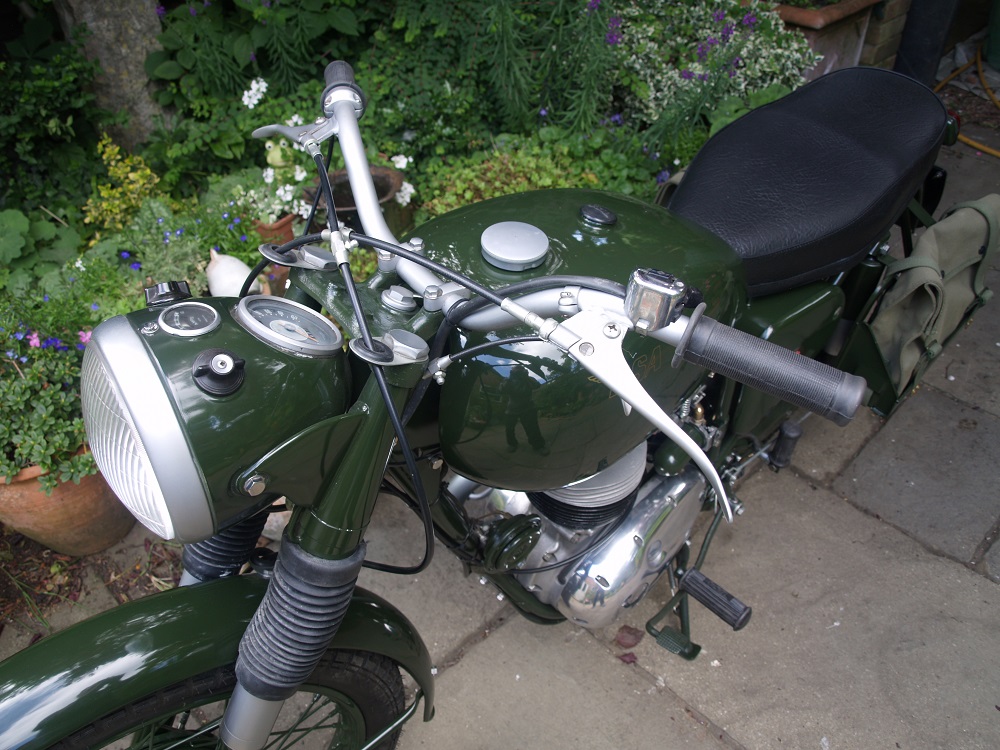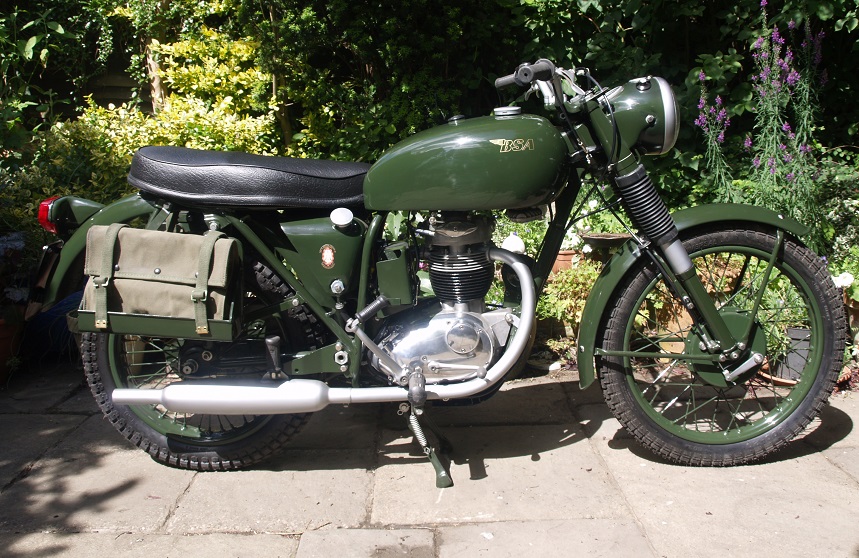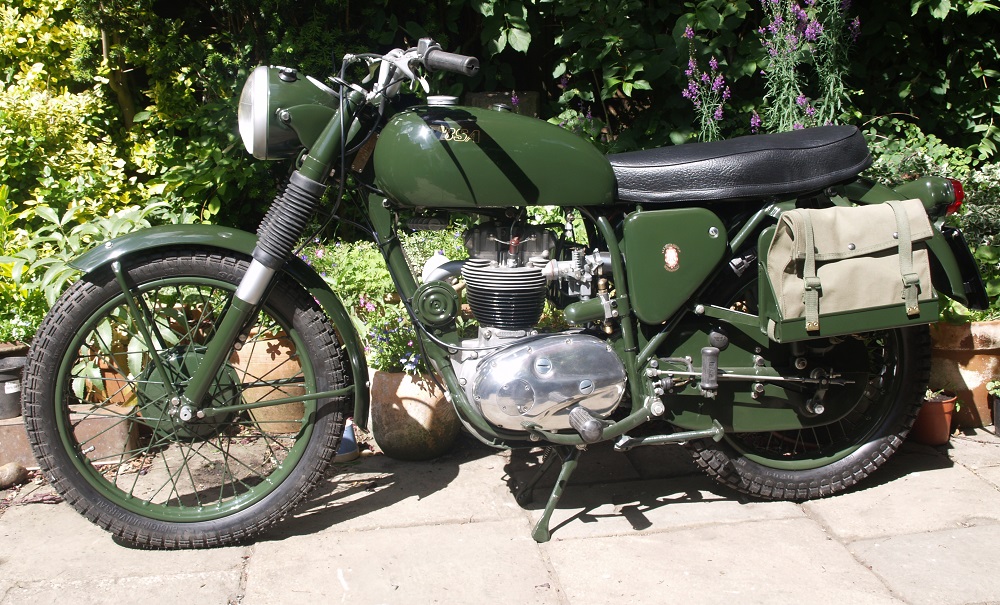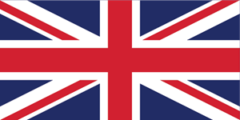As well as a passion for restoring BSA motorcycles, I also have a passion for ex-army bikes, possibly because my father was a Despatch Rider during WW2 and told me plenty of tales of his exploits both in North Africa and Burma. The BSA B40WD ticks both boxes for me and, in my opinion, is a very handsome and practical looking machine.
The MK1 B40WD was supplied to the British Army, the RAF and Royal Navy between 1967-1970. Just over 3000 of these motorbikes were built and were intended to replace the BSA WM20’s and Matchless G3L’s that had been used during WW2 and in the period afterwards. As well as being used by the British armed services, the B40WD was also used by other countries including Australia, Denmark and Jordan.
The B40WD is basically a road going motorcycle with limited off-road capability. It was mainly used by the army for convoy duty and for carrying despatches at a time when radio communication was not as good as it is now. It was used in particular with the British Army of the Rhine (BAOR) and would have been employed to escort convoys of military vehicles around the German countryside.
In 1968, the MK1 was revamped to MK2 standard to reflect changes made to the B25/B44 bikes which were then in production. These changes included a change in the carburettor to an AMAL 626 Concentric, the addition of a support rail for the rear mudguard and a change in the external engine filter to a British made one. However, by this time, the British Army had sufficient motorbikes and had no real interest in buying the MK2. BSA therefore tried to sell the motorbike in the civilian market as the BSA Roughrider but this was not a commercial success and very few of these motorbikes can now be found.
The B40WD makes use of a B40 350cc unit single with an external Vokes oil filter mounted on a bracket above the primary chaincase. The British Army has never had a clear policy on what size of engine is optimum for their use and has largely vacillated between 350cc and 500c machines. My view is that the 350cc machines were generally under powdered for their use, whereas, I think the 500cc machines were regarded by the army as a little too powerful. However, in the timescale that theB40WD was developed, I think a B44 engine might well have been a good compromise.
Despite using a B40 engine, the B40WD made use of the welded duplex frame and the front suspension from a B25/B44 which made it a much more rugged machine for army use than the earlier B40’s. It used the standard 18″ rear wheel size but used a 20″ front wheel that was common to off-road bikes at that time. Unfortunately, since modern off-road bikes use 21″ front wheels, getting hold of 20″ tyres can now be difficult at times. This one is fitted with the Ensign universal tyre which has a good block pattern for road use and limited off-road use.
The main changes to the military B40WD compared with its civilian versions were the fitting of panniers and pannier bags, a fully enclosed rear chain and a 3.5-gallon petrol tank that gave the bike an excellent range. It was also fitted with a very low ratio gearbox which, unfortunately, makes it very difficult to ride on modern roads, with the lower three gears being exceptionally low as shown in the table below. To overcome this problem, many owners fit them with the internals from a standard B40 gearbox.
| Gear | B40 | B40WD |
| 4 | 5.48 | 6.53 |
| 3 | 7.0 | 10.03 |
| 2 | 9.63 | 15.4 |
| 1 | 14.6 | 20.1 |
The B40WD is fitted with an AMAL 398 butterfly carburettor. The reason why this was used appears to have been that the military did not want a carburettor with a throttle valve, which they thought might stick open under adverse conditions. At this time, AMAL produced the 398 butterfly valve carburettor for simpler applications, such as stationary engines, and the military decided to adopt it. I have not ridden a B40WD fitted with one of these carburettors and most have now been retro-fitted with an AMAL concentric carburettor which are more suitable for motorcycle use.
In keeping with its military use, the B40WD is fitted with a large paper cartridge type air filter mounted inside the left-hand steel box which takes up the whole of the space inside the box. Surprisingly, the air intake to the filter is via the periphery of the slightly oversized and loose fitting cover. Since the battery could not also be accommodated inside this box, it was fitted on a separate carrier on the right-hand side between the engine and oil tank. In use, the battery was fitted with a glass fibre cover to try to protect it from the elements, both of which are held in place by a rubber strap and clip.
The controls are fairly standard on the B40WD. The butterfly carburettor has a separate butterfly valve for the choke with an operating lever on the carb and so there is no choke lever on the handlebars. There is a valve lifter fitted beneath the clutch lever, as was standard for all BSA of 350cc and above, although it is not really needed on a B40 engine. The headlight shell is fitted with a speedometer and ammeter together with ignition and lighting switches. There is no black-out switch fitted to the B40WD as found in later army motorbikes. The only other control is the horn/ headlight dipper switch on the left-hand side of the handlebars, which is of a fairly common pattern.
The B40WD used heavier duty front brake and clutch cables. Both of these cables, together with the throttle cable and valve lifter cable, are fitted with grease nipples to allow the cables to be re-greased easily. As a result of these heavier cables, the cable runs need to provide slightly larger bend radii than normal and this results in both cables crossing over the top steering yoke through the brackets mounted under the top fork nuts before looping back underneath the bottom steering yoke.
The B40WD used the same types of chromed components as on the standard BSA machines. The only concession to their military use was the use of dull chrome rather than the normal bright chrome to reduce its reflectivity. Unfortunately, dull chrome is not as durable as bright chrome, which probably meant that this finish did not last long in military use before rust started to take hold, and it was also much harder to keep clean. The bike would also have used un-polished engine covers unlike my restored example.
The BSA B40WD was used by the British Army during their, so-called, Deep Bronze Green period and many machines used on parade would have been painted in high gloss to give them a much smarter appearance. However, in the field, matt paint would have been used and, during their lifetime, would probably have been over-painted by hand many times. As with most military motorcycles, it’s very rare to find two B40WD’s painted in the same shade of green!
In summary, the BSA B40WD was probably a well-liked motorcycle during its use in the military and was much more modern than the war time bikes that had been used up to that point. It remained in service until the early 1980’s when it was replaced by the Can-Am Bombardier and, a few years later, by the Armstrong-CCM MT500. There seems to be a lot of B40WD’s still around and they can regularly be found on eBay in a range of conditions but, rarely, in restored condition. The BSA B40WD is a very practical motorbike but is very under-powered for my liking and would certainly have been much better with the more powerful B44 engine.
My B40WD Restoration
My particular BSA B40WD MK I was built in 1967 and was in a ‘well used’ condition when I bought it, although it was largely complete. Since it was located only 50 miles or so from where I live, and was fully taxed and had an MOT, I decided to ride it home rather than put it on the back of a trailer. This turned out to be a mistake! It wasn’t a pleasant ride with the handling being particularly poor which I subsequently found out was due the steering bearings having all but seized. It also did not want to stop very quickly because the front brake was very poor, even by single leading shoe standards. In addition, I discovered that the lower three gears on the B40WD were very low and almost unsuitable for road use. Top gear was not too bad but 50 mph was the maximum speed it was capable of.


As with most of the bikes I own, I decided to undertake a complete nuts and bolts restoration on it. I started with the engine after completely dismantling the bike. The engine was in reasonable condition but was completely overhauled and any suspect bearings were replaced together with all the oil seals. It was given a rebore and all the valves were replaced and the seats reground. The covers on the original engine would have been left unpolished but as with all my other BSA unit singles, I decided to polish the covers on this bike purely for show purposes.
The B40WD was originally fitted with an AMAL 398 butterfly carburettor. The reason why this type of carb was fitted was apparently because the army was not keen on carburettors with a throttle slides that might stick under adverse conditions. AMAL just happened to produce a butterfly carb at the time (for stationary engines!) and so this was chosen for the bike. However, most owners replace this carb with a concentric to give good performance on the road. For my bike, the previous owner still had the butterfly carburettor and I decided to refit it to show the bike in its original form.
One of the biggest and, perhaps, costliest jobs in restoring this particular bike was the re-chroming. Despite this being a motorbike designed for the military, it has as many chromed bits as on a standard B40 save for the tank panels. Rather than the standard bright chrome finish, the parts on the B40WD were given a dull chrome finish to stop them being reflective. Unfortunately, dull chrome is not as tough a finish as bright chrome and its matt finish also makes it much more difficult to keep clean. It is also about 10% more expensive to re-chrome. This particular bike is not intended for regular use on the road and therefore the dull chrome finish should be ok. However, if I had intended to ride it regularly, I might well have gone for bright chroming.
The other costly job on restoring a B40WD, is repainting all the parts in Deep Bronze Green which was the standard paint colour used by the army in the 1960/1970’s. Unfortunately, military bikes of this sort seem to have an enormous number of separate brackets and this one is particularly bad because of the way the panniers are mounted. Normally, the best approach is to bead blast all the metal and non-tin ware parts and then powder coat. Unfortunately, this could not be done with this bike because I could not remove the swinging arm. As is often the case, the swinging arm spindle had seized in the silent block bushes and would have been very hard to remove. The bushes were actually in very good condition and so there was not a compelling reason to attempt a full disassemble. As the swinging arm was still in place, I could not risk putting it through the powder coating process since this might have damaged the rubber bushes or led to leakage of grease from the spindle.
Instead, all the metal parts were spray painted in Deep Bronze Green and given a final clear coat. Most of the metal parts were in reasonably good condition except for the petrol tank. Unfortunately, once the paint was stripped off the tank, it showed all the signs of its past military life with numerous dents all over. The air box lid also seemed to be another piece of tinware that received more than its fair share of abuse. Similarly for the front and rear mudguards, which were bent out of shape in many places, again, as you would expect from hard military use. However, a bit of welding, panel beating and filling soon had these sorted.
The frame itself was in reasonable condition but showed signs of having been repaired in the past. As often seems to be the case with welded duplex frames, the side stand lug was freely rotating on the frame, presumably having suffered an impact at some point in its military career. The previous owner had simply taken off the side stand arm and used the centre stand instead. The best way of fixing the side stand lug is by brazing it to the frame tube, as done originally, Unfortunately, I do not have access to an oxy-acetylene torch that is required to heat up the parts sufficiently and, instead, I resorted to welding it back in place which works just as good.
The steering head bearing were in poor condition and had largely dried out and started to rust. The B40WD uses cone and ball bearings. A conversion kit to tapered roller bearings used on later BSA’s were available and, in principle, are much better than the original type of bearing. However, they are more expensive and I decided to stick with the ball and cones. The original cones were badly pitted but a replacement set were surprisingly difficult to get hold of. The upper and lower cones that fit into the steering head frame tube are common to other BSA’s but the cones that mount on to the steering head spindle are specific to the B40WD (and B44/B25) because of the diameter of the spindle.
Both the front and rear suspension components were badly worn. The rear shock absorbers were beyond salvage and were replaced by brand new equivalents. The only complication was that I had to re-use the lower chrome shrouds from the original units after getting them redone in dull chrome, which then replaced the bright chrome units on the new units. As always seems to be the case, the front fork stanchions were completely unusable as they were badly pitted in rust. These were replaced, as were the bushes and seals and gaiters.
The wiring harness on the B40WD is relatively simple and most of it was still in reasonable condition. The only part that needed to be replaced was the cables that go to the back light unit. On the B40WD, the 12V electrics use a Zener diode mounted on a heat sink hung from a bracket bolted to two lugs under the front of the petrol tank. The 12V ignition coil is mounted underneath the top tube on the frame and hangs down within the petrol tank tunnel. Underneath the saddle, the wiring harness is very simple and the only electrical component there is the rectifier that is normally bolted on the back mudguard. However, since this position is a little exposed, I decide to move it to hang underneath the cross-bracket under the seat to which the back of the oil tank is bolted. This way, the rectifier sits just above the oil tank, which seems a safer, more practical location.
The B40WD uses a circular paper air filter mounted in the box on the left-hand side of the bike, not unlike that in the OIF B25/B50’s but smaller in diameter. It is held in place by an outer circular cover and a large metal gauze filter. The overhaul design of the air box is a little unusual in that the air inlet to the filter is via a small gap between the air box and the outer cover that is held in place by an Oddie stud. The paper cartridge on my B40WD was in reasonable condition and still usable which was lucky because new ones are no longer available.
The engine uses an external Vokes filter mounted on a bracket on the left-hand side just above the chaincase. These types of filter were in common use in military vehicles in the 1960/1970’s and look similar to the British filter mounted on OIF B25’s. The filter elements required for the B40WD are no longer available but, fortunately, if still in reasonable condition, they can be washed out and cleaned using petrol.
The B40WD uses a 3.50 x 18 rear tyre and a 3.00 x 20 tyre on the front. The 20″ front tyre was normal at the time for off-road use but is now more difficult to find due to 21″ now being the norm for off-road. The B40WD came with a 20″ Ensign universal tyre that seems to be produced at various times in small batches. It has a block pattern tread which is ideal for this particular bike for use on the road and for limited off road use.
My B40WD is fitted with pannier bags, which are modern pattern replacements and are made occasionally in batches for B40WD owners. They are heavily waxed and would provide a reasonably water tight enclosure for despatches, etc. As with most military bikes, the fitted panniers and bags provide a useful means for carrying spares and other items although they can make getting on and off the bike a bit more difficult!
BSA B40WD Specifications
- Engine: Single cylinder, OHV, 2-valve, 4-stroke
- Starting: Kickstart only
- Capacity: 343 cc
- Bore/Stroke: 79 x 70 mm
- Compression Ratio: 7.1:1
- Max Power: 20 hp
- Carburettor: Amal 398 butterfly carburettor
- Cooling: Air cooled
- Lubrication: Dry sump
- Ignition: Coil and contact breaker points
- Transmission: 4 speed foot shift
- Final Drive: Chain
- Front Suspension: Coil spring and hydraulically damped
- Rear Suspension: Coil spring and hydraulically damped
- Front Brake: 7 inch drum single leading shoe
- Rear Brake: 7 inch drum single leading shoe
- Frame: Welded duplex
- Rake Angle: 65 deg
- Wheel Base 53 inch
- Seat Height: 32 inch
- Front Tyre 3.00 x 20 inch
- Rear Tyre: 3.50 x 18 inch
- Ground Clearance: 7 inch
- Dry Weight: 165 kg
- Fuel Tank: 3.5 gallons
- Oil Tank: 5 pints
BSA B40WD Parts Suppliers
Some B40WD spare parts are relatively easy to get hold of with many good suppliers easily found on the internet. Two of the larger suppliers of BSA parts are Burton Bike Bits and Dragonfly Motorcycles.
25,816 total views, 12 views today


